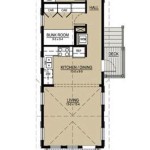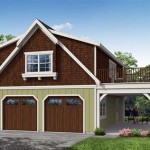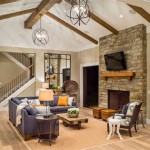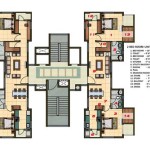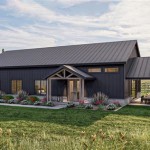Mother-In-Law Suite Floor Plans: Enhancing Multi-Generational Living
Mother-in-law suites, also known as accessory dwelling units (ADUs), in-law apartments, or granny flats, are self-contained living spaces integrated within or adjacent to a primary residence. These floor plans are designed to accommodate family members, typically aging parents, adult children, or other relatives, while maintaining a degree of privacy and independence for both parties. The appeal of mother-in-law suite floor plans lies in their ability to facilitate multi-generational living, providing a supportive and convenient environment for families.
The decision to incorporate a mother-in-law suite into a home design necessitates careful consideration of various factors, including zoning regulations, building codes, budget constraints, and the specific needs of the occupants. Thoughtful planning and design are crucial to ensure the suite is functional, comfortable, and seamlessly integrated into the overall aesthetic and layout of the primary residence. This article will explore key aspects of mother-in-law suite floor plans, highlighting design considerations, benefits, and practical applications.
Understanding the Essential Components of a Mother-In-Law Suite
A true mother-in-law suite typically comprises several essential components that allow for independent living. These core elements distinguish it from a simple guest room or an extra bedroom and are crucial for providing a comfortable and self-sufficient living environment.
A Private Entrance: A separate entrance is paramount for maintaining privacy and autonomy for the occupant(s) of the suite. This entrance should be distinct from the main entrance of the primary residence, granting easy access without disrupting the household. The entrance can be a dedicated doorway on the side of the house, a back entrance leading from a patio or garden, or even an entrance accessible via a covered walkway.
A Fully Equipped Kitchen: A functional kitchen is a cornerstone of a mother-in-law suite. It should include essential appliances such as a refrigerator, stove or cooktop, oven, and microwave. Counter space, ample storage cabinets, and a sink are also crucial for preparing meals and managing kitchen tasks. The size and features of the kitchen can be scaled down to fit the available space, but it should be fully equipped to ensure independent meal preparation.
A Private Bathroom: A dedicated bathroom is essential for privacy and convenience. The bathroom should feature a toilet, sink, shower, or bathtub. Accessibility considerations are often a key factor in bathroom design for mother-in-law suites. Features like grab bars, walk-in showers, and comfort-height toilets can significantly enhance the safety and usability for elderly or mobility-impaired occupants.
A Living Area: A comfortable living area provides a space for relaxation, entertainment, and socialization. This area should be adequately sized to accommodate seating, a television, and personal belongings. The living area layout should be flexible enough to be personalized to the occupant's preferences and needs. Natural light and ventilation are important considerations for creating a comfortable and inviting living space.
A Bedroom: A private bedroom is a fundamental component of a mother-in-law suite. The bedroom should be adequately sized to accommodate a bed, dresser, nightstand, and closet space. Adequate lighting, ventilation, and privacy are crucial for creating a restful and comfortable sleeping environment. The bedroom should be designed to minimize noise from adjacent areas of the house.
Exploring Different Types of Mother-In-Law Suite Floor Plans
Mother-in-law suites can be integrated into a home in various ways, each with its own set of advantages and considerations. The optimal floor plan depends on factors such as the existing house structure, available space, budget, and the specific needs of the occupants. Several common types of mother-in-law suite floor plans exist.
Attached Mother-In-Law Suite: An attached suite is physically connected to the main house, often sharing a wall or roofline. This arrangement allows for easy access between the main house and the suite, providing convenience and promoting interaction. However, it also requires careful attention to soundproofing and privacy considerations. Common locations for attached suites include additions to the side or rear of the house, or converted garages.
Detached Mother-In-Law Suite: A detached suite is a separate structure located on the same property as the main house. This configuration offers maximum privacy and independence for both parties. Detached suites are often built as backyard cottages, converted sheds, or stand-alone apartments above a garage. Zoning regulations may impose restrictions on the size and location of detached ADUs, so thorough research is essential before beginning construction.
Basement Mother-In-Law Suite: Converting a basement into a mother-in-law suite can be a cost-effective option, especially if the basement already has existing utilities and a separate entrance. Basement suites can be challenging to design due to limited natural light and potential moisture issues. Adequate ventilation, proper insulation, and the installation of egress windows are important considerations for ensuring a comfortable and safe basement suite.
Above-Garage Mother-In-Law Suite: Building a suite above a detached garage can be a practical and economical way to add living space to a property. This option minimizes the footprint on the yard while providing a separate living area. Access to an above-garage suite typically involves an exterior staircase, which may pose challenges for elderly or mobility-impaired occupants. Careful planning is required to ensure the suite is adequately insulated and soundproofed from garage noise.
Key Considerations When Designing a Mother-In-Law Suite
Designing a functional and comfortable mother-in-law suite requires careful planning and attention to detail. Several key considerations can significantly impact the usability and overall success of the suite.
Accessibility: Accessibility is paramount, especially if the suite is intended for elderly or mobility-impaired individuals. Features such as zero-threshold entrances, wide doorways, grab bars in bathrooms, and lever-style door handles can significantly enhance accessibility and safety. Ramps or elevators may be necessary for accessing suites on upper floors or basements.
Privacy: Maintaining privacy for both the occupants of the main house and the suite is crucial for harmonious multi-generational living. Soundproofing walls and floors, separate entrances, and strategically placed windows can help minimize noise and visual intrusions. Landscaping can also be used to create visual barriers and enhance privacy.
Zoning and Building Codes: Before commencing any construction, it is crucial to thoroughly research and comply with all applicable zoning regulations and building codes. These regulations may dictate the size, location, and features of ADUs. Failure to comply with these regulations can result in fines, legal issues, or even the forced removal of the suite.
Utilities: Determine whether the suite will share utilities with the main house or require separate meters for electricity, water, and gas. Sharing utilities can simplify the initial construction process but may complicate utility billing and create disputes over usage. Separate meters provide greater autonomy but require more extensive plumbing and electrical work.
Ventilation and Natural Light: Adequate ventilation and natural light are essential for creating a healthy and comfortable living environment. Windows should be strategically placed to maximize natural light and provide ventilation. Ensure proper insulation and air sealing to prevent drafts and reduce energy consumption. Consider installing skylights or solar tubes to bring additional natural light into darker areas of the suite.
Storage: Ample storage space is crucial for minimizing clutter and maximizing functionality. Incorporate built-in cabinets, closets, and shelving to provide storage for personal belongings, linens, and household items. Consider adding attic or basement storage space if available.
Safety Features: Install smoke detectors, carbon monoxide detectors, and fire extinguishers to ensure the safety of the occupants. Consider installing a security system to provide added peace of mind. Ensure adequate lighting both inside and outside the suite to enhance visibility and deter crime.
Mother-in-law suite floor plans offer a valuable solution for families seeking to accommodate aging parents, adult children, or other relatives. By carefully considering design elements, types of suites, and key considerations, families can create a comfortable and functional living space that fosters independence and promotes multi-generational living.

Homes With Mother In Law Suites

In Law Suite Plans Give Mom Space And Keep Yours The House Designers

Small Mother In Law Suite Floor Plans Home Design Cottage Apartment House

Mother In Law National Home Builders

Mother In Law Suite Floor Plans Resources

6 Bedroom Country Style Home With In Law Suite The Plan Collection

Exclusive Brick Clad House Plan With Mother In Law Suite 510210wdy Architectural Designs Plans

French Country In Law Suite House Plan Home 153 1491

House Plans With In Law Suite Floor Designs

Spacious House Plan With Mother In Law Suite 3568 Sq Ft 5906nd Architectural Designs Plans

